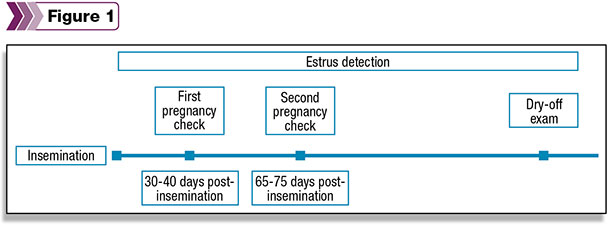Reproductive efficiency on a dairy is an important factor in overall profitability, and a sizable amount of labor is involved in the synchronization or estrus detection and insemination of cows and heifers. That is why an open cow at pregnancy check is so frustrating.
Time, money and other resources have resulted in a negative note on the checklist. A frustration I have heard voiced several times is not knowing when or why cows lose pregnancies.
Unfortunately, the list of possible “whys” is long and, more than likely, somewhat specific to factors like your farm’s location and climate. What we can narrow down a bit, however, is the “when.”
Common methods of pregnancy detection
The rate of pregnancy loss is variable among farms, as is the method of pregnancy detection used. There are several methods of pregnancy detection employed on progressive dairy operations, including:
- Monitoring cattle for return to estrus
- Rectal palpation
- Ultrasound
- Blood or milk sample to test for pregnancy-associated glycoproteins (PAG)
Cattle that have been bred but fail to become pregnant should return to estrus in approximately 21 days. The observation of a cow or heifer standing to be mounted during this time frame post-insemination is the most basic method of determining pregnancy status.
Observation of return to estrus, however, is not a reliable method of pregnancy detection, as it does not prove the presence of a viable pregnancy, just the presence of estrous behavior.
Palpation of the reproductive tract is a common, quick and accurate method of pregnancy detection when performed by a skilled practitioner. Palpation can accurately detect pregnancy at approximately 35 days post-insemination, and a highly skilled practitioner has the ability to accurately detect closer to 32 days.
Ultrasound of the reproductive tract is another method of pregnancy detection commonly employed on dairy farms across the country. There are several benefits of ultrasound compared with palpation, most evident in the information available to the practitioner.
The embryo can be visualized and a heartbeat can be confirmed, ovarian activity can be monitored, uterine health can be examined, and fetal sex can be determined, all with the use of ultrasonography.
Another advantage of ultrasound is that it can be used as early as 26 days of gestation for accurate pregnancy detection, although it is commonly used between 30 to 40 days.
The use of chemical pregnancy tests to detect PAGs has proven to be another reliable method of pregnancy detection. The presence of PAGs is pregnancy specific, and commercially available test kits are labeled to detect pregnancy at 28 to 29 days post-insemination.
These tests have become increasingly sensitive with alterations, and studies have now shown PAGs can be detected in milk samples at quantities high enough to diagnose pregnancy comparable to PAG detection in blood. The use of this technology is becoming more common, especially in areas with limited access to skilled veterinarians.
When are embryos most likely to die?
Timelines and reasons for embryonic loss are variable, with lactating dairy cattle representing a unique niche of cattle suffering from prolonged periods of embryonic and fetal loss.
Generally speaking, embryonic loss occurs between the point of fertilization to day 42 of gestation, and fetal loss occurs from day 42 of pregnancy to calving. The rate of embryonic loss is debated, but it has been estimated that up to 40 percent of embryonic loss occurs before day 15 of gestation. A recent study reports a 5 to 10 percent loss between 14 and 18 days of gestation and an additional 5 to 10 percent loss from days 29 to 42 of gestation.
Late embryonic loss and fetal loss typically occurs at a lesser rate but is arguably more detrimental to dairy producers due to the larger loss of investment in both capital and time. Several studies have investigated the occurrence of embryonic loss through day 42 of gestation; however, evidence indicates that in lactating dairy cattle, the rate of late embryonic and early fetal loss is still relevant through day 56 of gestation.
In more than 4,800 lactating dairy cattle examined between days 28 and 58 of gestation, on average 12.8 percent of the cattle experienced an abortion. This is greater when compared with the 10.8 percent reported for lactating beef cows during the same period.
When to check for pregnancy?
With those numbers in mind, the next question is: When is the best time to pregnancy check? The goal of an efficient pregnancy detection system is to identify open cows as soon as possible so they can be rebred in a timely manner.
The strategic scheduling of pregnancy checks and, if applicable, the continued tail chalking of pregnant pens, can assist in locating open cows sooner.
The first pregnancy check is focused on detecting cows that are open following an insemination. We know the majority of embryonic deaths occur before a pregnancy check is possible (less than 25 days), so the sooner the first pregnancy check occurs, the sooner cows can be re-inseminated.
This typically means between 30 to 40 days post-insemination for a palpation or ultrasound herd but can be as quick as 28 to 29 days if chemical pregnancy tests are implemented.
The second pregnancy check should be focused on finding cows with embryos that were lost between the first pregnancy check and approximately 65 days post-insemination. Research shows that the rate of embryonic death is still continuing to decrease sharply between days 42 and 56 post-insemination but levels off and decreases by only a few percentage points from days 56 to 98.
The placenta is also beginning to form functional placentomes (the placental connection between the fetus and the uterus) around day 42 of pregnancy, which is attributed to lower risk of embryonic loss (Figure 1).

These two time points for pregnancy detection are focused on the time period during which embryos are most susceptible to death. For most operations, an efficient estrus detection program should be sufficient to identify the remaining cows that require a pregnancy check for an abortion until dry-off.
The timeline suggested here is based on research data and landmarks in embryonic growth and can be shifted to accommodate veterinary schedules or management practices. PD
References omitted but are available upon request. Click here to email an editor.

-
Tyler Stratman
- National Account Consultant
- Genex Cooperative Inc.
- Email Tyler Stratman






